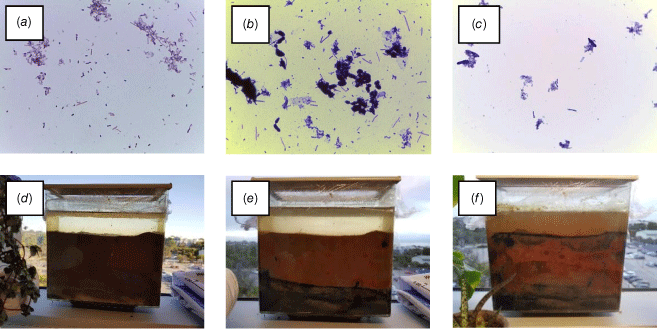Investing in the STEM workforce: microbiological safety in Australian secondary schools
Megan Lloyd A * , Teresa Gigengack B , Rita Steffe B and Priscilla Johanesen
A * , Teresa Gigengack B , Rita Steffe B and Priscilla Johanesen  C
C
A School of Biomedical Sciences, University of Western Australia, QEII Medical Centre, Nedlands, WA, Australia.
B Science Australian School Science Information Support for Teachers and Technicians (Science ASSIST), Australian Science Teachers Association (ASTA), Deakin West, ACT, Australia.
C Department of Microbiology, Monash Biomedicine Discovery Institute, Faculty of Medicine, Nursing and Health Sciences, Monash University, Clayton, Vic., Australia.

Dr Megan Lloyd is an Adjunct Lecturer at the School of Biomedical Sciences, University of Western Australia and is a past Convenor of the Education Special Interest Group (EdSIG) of ASM. |

Teresa Gigengack is the manager of Science ASSIST and has more than 25 years’ experience in supporting practical activities in school science. |

Rita Steffe is an advisor for Science ASSIST (ASTA), a part-time teacher for NSW TAFE and a laboratory technician in secondary school science. She previously worked as a senior technical officer in the Department of Infectious Diseases at the University of Sydney. |

Prof. Priscilla Johanesen is an education-focussed academic in the Department of Microbiology and the Associate Dean, Research Training, Faculty of Medicine, Nursing and Health Sciences at Monash University. Priscilla is a past Convenor of EdSIG. |
Microbiology Australia 44(3) 152-155 https://doi.org/10.1071/MA23044
Submitted: 14 June 2023 Accepted: 25 July 2023 Published: 4 August 2023
© 2023 The Author(s) (or their employer(s)). Published by CSIRO Publishing on behalf of the ASM. This is an open access article distributed under the Creative Commons Attribution-NonCommercial-NoDerivatives 4.0 International License (CC BY-NC-ND)
Abstract
Microbiology is increasingly being incorporated into secondary school biology curricula, an important component of science technology engineering and mathematics (STEM) training. The microbiological competency of teachers and the availability of skilled laboratory technicians that understand the risks involved and the reasoning behind restrictions to protocols is vital for the safe execution of microbiology experiments in secondary schools. The addition of gene-modification experiments to microbiology curricula increases the complexity of experimental set-up and potentially exacerbates existing deficiencies in laboratory technique and disinfection practice. There is currently no targeted national program to up-skill school science teachers or laboratory technicians, which can leave these staff in vulnerable positions if they are asked to co-ordinate experiments that are beyond their expertise. It is important that such training is available, preferably as part of well-planned professional development and that continued online support is provided to answer questions swiftly and assist STEM school staff to conduct microbiology experiments safely. Improved integration between universities and high schools can be beneficial in this regard, not only in the safe teaching of microbiology in schools, but also in collaborative links formed between secondary schools and universities.
Keywords: genetically modified organisms, laboratory technicians, online assistance, student learning, student safety, teacher training, technician training.
Introduction
Microbiology is understandably a popular topic in secondary schooling. The excitement of seeing bacteria growing on a plate or microorganisms under the microscope is something shared by all of us who teach this subject. The relatability to health practice (e.g. bacteria growing from a handprint plate) is often memorable as it makes a theoretical concept (bacteria on our skin) literally come to life. These concepts are increasingly important in STEM teaching, particularly in the post-COVID era. In the secondary school science laboratory, experiments that demonstrate bacteria in probiotic food products such as yoghurt or kombucha by staining or simple culture, constructing closed Winogradsky columns from estuarine river mud and viewing protozoa in pond water are simple experiments that illustrate the ubiquitous nature of microorganisms (Fig. 1). Playdough is also a wonderful medium for developing models of microorganisms to improve recall of structures. Other investigations such as defining the sensitivity of Risk Group 1 bacteria1,2 to common disinfectants and growth experiments using simple nutrient agar are often carried out in the final years of secondary schooling and provide a great introduction to tertiary microbiology as well as increasing public knowledge about microorganisms (discussed in Timmis et al. 20193 and Lloyd and Berry 20224).
Activities used in microbiological teaching. (a) Commercial kimchi Gram stain. (b) Commercial sauerkraut brine Gram stain. (c) Commercial kombucha, Gram Stain. (d–f) Winogradsky columns, at (d) setup, (e) 1 month later and (f) 5 months later (All images, M. Lloyd).

Although both engaging and educational, many activities have risks associated with their set up, evaluation and decontamination without competent microbiological technique.5 These risks are significantly reduced by providing limits to experimental guidelines (e.g. no use of enriched, selective or differential agars, no subculturing, no sampling from surfaces likely to harbour pathogens such as toilet seats and limiting incubation temperatures to 30°C6). It is imperative that the logic behind these restrictions is understood. Most of the behind-the-scenes set up and clean up or disinfection in secondary school laboratories is carried out by laboratory technicians (LTs) who already have diverse and demanding roles. The experience and training of secondary school LTs in the discipline of microbiology can range from having no microbiology experience (generally being trained in-house by the predecessor) to having formal qualifications (TAFE, undergraduate or postgraduate) and extensive lab-based experience. In an anonymous online survey distributed by science teaching groups throughout Australia in 2020, more than 76% of responding teachers and LTs indicated that they wanted additional support or further training with respect to microbiology teaching at their schools (Teresa Gigengack, Science Australian School Science Information Support for Teachers and Technicians (Science ASSIST) survey performed June 2020, n = 605).
Safety concerns in microbiology teaching
Some experiments that might seem innocuous in the classroom setting, can be catastrophic for some students if there is a lack of knowledge and risk assessments are not performed. An example of this is the seemingly simple ‘mould bread experiment’ in which bread is placed in a resealable sandwich bag and placed in a warm incubator or room. If there is heavy growth of fungal species and the sample does not remain sealed and is removed from the bag, countless fungal conidiospores are released, which may cause allergic reactions, asthma or other respiratory problems for those in proximity.7 Importantly, in secondary schools, laboratories are likely to be used by multiple classes, so this risk may be spread across the school community throughout the day. Accordingly, this type of experiment is not recommended in schools (closed culture is fine, but the growth container must remain closed during evaluation and proper disposal of containers must occur).
There is nothing better for student learning and engagement than for students to undertake their own experiments in the classroom.8,9 Many school science laboratories are not at Physical Containment Level 1 (PC1), which precludes many microbiological practical activities. However, if PC1 standards are in place and safety can be maintained, students and staff can work safely with microorganisms without resorting to demonstration-only experiments. Risk assessments must be carried out to identify the potential hazards and protocols should be modified to reduce risk where possible. All methodology should be clearly explained to the students, and their understanding of the associated risk should be assessed. To assist both LTs and teachers, Science ASSIST provides risk assessment templates (e.g. https://assist.asta.edu.au/resource/2298/risk-assessment-template) and a risk-severity matrix may be useful (an example is provided in Fig. 2). Points of risk will usually involve the creation of aerosols (e.g. sub-optimal use of a loop and Bunsen burner, opening and transferring liquid cultures with spillage and aerosol risks). Coordination between trained teachers and LTs is important to ensure that instruction is clear and that students understand how to remain safe during these activities and what to do if things go wrong. Physical means of risk reduction (e.g. using racks to reduce accidental spillage of liquid samples) are effective and the provision of microbiology-specific spill kits need to be carefully considered (as there are also risks associated with quantities of 70% ethanol and bleach). The increasing impacts of antimicrobial resistance should also be considered as a potential risk as skin flora are potentially highly resistant to antibiotics, underscoring the importance of not subculturing from plates derived from environmental or personal samples.10 It is also important that schools effectively decontaminate and sterilise items from practical classes, as this waste will ultimately be discarded in the standard rubbish stream. The incorrect handling of microorganisms could lead to possible laboratory-acquired infections, or the release of unwanted microorganisms outside of the laboratory.
Risk severity matrix. This matrix allows an evaluation of the risk level of an activity to be calculated. Points of risk are identified and the likelihood of them occurring is multiplied with the likely effect. For example, an activity containing a highly unlikely event that has a potentially severe outcome is a medium risk activity. Risk for an activity should be no greater than low or medium. Note that microbiological risk will always be increased where participants are undergoing treatments such as immunosuppressive therapy or have health concerns such as respiratory disease (e.g. cystic fibrosis). The affected participant should receive medical advice before being allowed to undertake any microbiological activity. This simple example of a risk severity matrix was adapted from https://www.smartsheet.com/content/risk-assessment-forms.

In addition to the growth and culture of microorganisms, more recently, concepts such as bacterial transformation, previously the domain of tertiary education, are being introduced into the broad upper secondary school curriculum. It is important in these instances to think about why such experiments would need to be included as student activities – do they fit within the curriculum? Do they help the students to understand and retain the content? Are the students able to understand these concepts? By performing these experiments, risks associated with the potential release of genetically modified (usually penicillin-resistant) microbes emphasise the importance of appropriate technique and optimal disinfection and sterilisation practises. Schools failing to adequately disinfect and sterilise products from these experiments theoretically may have to answer to the Office of the Gene Technology Regulator (https://www.ogtr.gov.au/). This agency assumes not only that school decontamination regimes are sufficient, but that due diligence is performed checking that the organisms in GMO kits are suitable for PC1 laboratories.11 Schools undertaking these higher risk activities need to keep good records of the kits used and the sterilisation undertaken.
Science ASSIST is a national online advisory service for school science educators and LTs that has provided support since 2013. This service supplies expert advice on all aspects of school laboratory safety, management, and design as well as high-quality teaching and learning resources. Science ASSIST began as a stand-alone service funded by a federal grant and is now part of the Australian Science Teachers Association and operates under a subscription model. Members of subscribing schools can ask questions and receive answers from professionals with experience teaching science in secondary schools. This service has developed the ‘Guidelines for Best Practice for Teaching Microbiology in Australian Schools’, which was prepared with the contribution of members of the ASM Education Special Interest Group.12
The safe teaching of microbiology in schools – the way forward
As microbiologists, we appreciate how engaging the world of microbiology is and the importance of increasing understanding and inspiring students in our discipline and thus we advocate for the continued teaching of microbiology at the secondary level. One potential solution for schools is to approach local universities to see whether they are interested in working with them to develop and provide activities that utilise suitable laboratory space and trained personnel to allow students to complete these activities in the appropriate physical containment, with suitable equipment for a reasonable cost. This can lead to improved collaboration between the secondary and tertiary sectors and potentially alert secondary school students to tertiary opportunities in STEM that they may not otherwise have considered.
It is important that secondary school science technicians and teachers are upskilled and feel confident in the execution of microbiology practical activities in the secondary school setting. One of the ways this could occur is through professional development, specifically microbiology training courses. Currently, although there are some industry-focussed microbiology short certification courses (microcredentials) available in Australia, these are not context-specific and practical exercises do not reflect the equipment or even the physical containment present in most school classroom settings. Although microcredentials would need to be operated and administered through tertiary institutions, they should have carefully selected, contextualised content that upskills teachers and LTs with a focus on risk analysis and safety, the reasoning underpinning restrictions to microbiological activities in schools, and theory and hands-on practical activities based on current curricula. A wholly online microcredential would not be sufficient to develop the hands-on skill set needed to deliver microbiology practical activities safely and effectively. Building on current practice, it would be logical to integrate Science ASSIST into the development of LT and science teacher-focussed microcredentials, and to ensure sufficient funding for this service to answer new questions, to oversee and detect when new protocols are being trialled by schools (through questions submitted to the website) and potentially to allow new hazards to be dealt with quickly, through bulletins and alerts (for example, making hand sanitiser without checking the percentage of ethanol, potentially making an ineffective product). Upskilling science teachers and LTs should be recognised by school administrators as being critically important for maintaining student safety and microbiology teaching microcredentials could form part of formal professional development for all participants.
Conclusions: the future for microbiology in the secondary school classroom
Microbiology is a fascinating scientific discipline and given the last couple of years there is no time like the present to keep students engaged in the world of microbiology. Achieving this in the classroom in a safe manner is critically important. As educators and discipline experts we need to ensure that LTs and science teachers can upskill with relevant and topical courses and that information on microbiological safety remains easily accessible to all. After all, today’s student could be tomorrow’s microbiology researcher or educator.
References
2 World Health Organization (2004) Laboratory Biosafety Manual, 3rd edn. World Health Organization. https://www.who.int/publications/i/item/9241546506
3 Timmis K et al. (2019) The urgent need for microbiology literacy in society. Environ Microbiol 21, 1513-1528.
| Crossref | Google Scholar |
4 Lloyd ML, Berry JA (2022) Chapter 5 – Improving public understanding of microorganisms by integrating microbiology concepts into science teaching throughout the education system. In Importance of Microbiology Teaching and Microbial Resource Management for Sustainable Futures (Kurtböke İ, ed.). pp. 107–133. Academic Press.
5 Redfern J et al. (2013) Practical microbiology in schools: a survey of UK teachers. Trends Microbiol 21, 557-559.
| Crossref | Google Scholar |
6 Emmert EAB, , ASM Task Committee on Laboratory Biosafety (2013) Biosafety guidelines for handling microorganisms in the teaching laboratory: development and rationale. J Microbiol Biol Educ 14, 78-83.
| Crossref | Google Scholar |
7 Mazur LJ, Kim J (2006) Spectrum of noninfectious health effects from molds. Pediatrics 118, e1909-e1926.
| Crossref | Google Scholar |
8 Shana Z, Abulibdeh ES (2020) Science practical work and its impact on students’ science achievement. J Technol Sci Educ 10, 199-215.
| Crossref | Google Scholar |
9 Needham R (2014) The contribution of practical work to the science curriculum. Sch Sci Rev 95, 63-69.
| Google Scholar |
10 Lee JYH et al. (2018) Global spread of three multidrug-resistant lineages of Staphylococcus epidermidis. Nat Microbiol 3, 1175-1185.
| Crossref | Google Scholar |
12 Science Assist (2017). Guidelines for best practice for microbiology in Australian Schools. Australian Science Teachers Association. https://assist.asta.edu.au/resource/4196/guidelines-best-practice-microbiology-australian-schools


